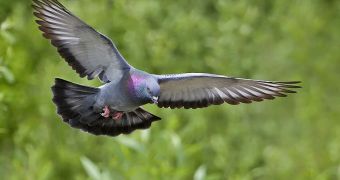In a new scientific study, researchers have finally managed to get a clearer image of how pigeons organize their flocks when flying together in large groups, and over long distances. The investigators determined the that birds which were the most savvy in the “flight-related business” were always in front, while the rest of the flock was made up of a clearly-established hierarchy of individuals. The General rule the scientists found was that the most unskilled pigeons tended to fly last, while those in the middle of the group had average flight knowledge, Wired reports.
Navigational skills appear to be the only determinant that dictates the order in which pigeons fly when traveling long distances. This type of hierarchy is fairly uncommon in the animal world, where most of the time, domination is established through brute force and violence. However, these birds appear to have discovered a method of establishing flight orders without individuals having to engage in conflicts with each other. “A pecking order tends to be just that – a pecking order,” explains Princeton University collective behavior expert Iain Couzin. He was not involved in the new study.
The work was conducted by researchers at the Eotvos Lorand University in Budapest, Hungary, led by biological physicist Tamas Vicsek. The team focused its attention on a group of homing pigeons. The reason why they selected this particular type of pigeon is that the animals tend to perform long flights, but also return home to their nests. For this reason, the researchers trapped some 13 of the birds, and then outfitted them with small backpacks, each containing a GPS device sensitive enough to measure the changes in speed, altitude and direction about five times each second.
In the experiments, the pigeons were released, and made to travel about 14 kilometers back to their nests. They were either allowed to fly in group, or solo, and the researchers analyzed the navigational skills of each of the “test subjects.” It was determined following flight analysis that, each time a group flew, the pigeon that exhibited the best navigational skills in solo flight led the flock. The leading bird was always followed by three or four other good fliers, which were in turn followed by three or four pigeons each, and so on. “These pigeons know each other. They know which is the smartest. The fastest bird will even follow the slower one who knows the way home the best,” the team leader says.

 14 DAY TRIAL //
14 DAY TRIAL //